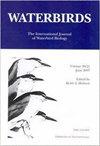Overwinter Movement of Atlantic Puffins (Fratercula arctica) Breeding in the Gulf of Maine: Inter- and Intra-Colony Effects
IF 0.6
4区 生物学
Q3 ORNITHOLOGY
引用次数: 4
Abstract
Abstract. To identify potential threats and prioritize areas for protection, modern conservation efforts rely on spatial data. While it is often impossible to study the movements of entire populations, we can examine patterns among individuals and groups to better understand populations as a whole. We used geolocator tags to determine where Atlantic Puffins (Fratercula arctica) at the southern edge of their range, vulnerable to warming waters and anthropogenic influence, spend the nonbreeding season, and whether birds from different colonies or parts of the same colony used different overwintering strategies. Between 2013 and 2017, tags were deployed on 97 puffins breeding on three islands in the Gulf of Maine: Machias Seal Island, Matinicus Rock, and Seal Island National Wildlife Refuge. Most tagged puffins remained in or near the Gulf of Maine throughout the autumn and early winter months, venturing as far south as Cape Hatteras (ca. 35°N) in February, March, and April, before returning to their respective colonies. Three individuals travelled north to the Gulf of St. Lawrence and waters around Newfoundland immediately after breeding, returning to the Gulf of Maine in mid-winter. We found no evidence of inter- or intra-colony differences in overwinter movement. This is the first study focusing on overwinter movements of puffins breeding at the southern edge of their range in North America and can assist in the development of policy regarding management and protection of important marine areas for puffins and other species.缅因湾大西洋海雀(北极海雀)越冬运动:种群间和种群内的影响
摘要为了识别潜在的威胁并确定保护区域的优先顺序,现代保护工作依赖于空间数据。虽然研究整个人口的流动往往是不可能的,但我们可以研究个人和群体之间的模式,以更好地了解整个人口。我们使用地理定位器标签来确定大西洋海雀(Fratercula arctic)在其活动范围的南部边缘,易受变暖的海水和人为影响,度过非繁殖季节,以及来自不同种群或同一种群部分地区的鸟类是否使用不同的越冬策略。在2013年至2017年期间,在缅因湾的三个岛屿上繁殖的97只海雀身上部署了标签:马基亚斯海豹岛、马蒂尼科斯岩石和海豹岛国家野生动物保护区。大多数被贴上标签的海雀在整个秋季和初冬的几个月里都呆在缅因湾或其附近,在2月、3月和4月冒险南下到哈特拉斯角(北纬35°),然后返回各自的栖息地。三个个体在繁殖后立即向北前往圣劳伦斯湾和纽芬兰周围的水域,在隆冬返回缅因湾。我们没有发现越冬运动中群体间或群体内差异的证据。这是第一次集中研究在北美范围的南部边缘繁殖的海雀越冬运动,可以帮助制定有关海雀和其他物种管理和保护重要海洋区域的政策。
本文章由计算机程序翻译,如有差异,请以英文原文为准。
求助全文
约1分钟内获得全文
求助全文
来源期刊

Waterbirds
生物-鸟类学
CiteScore
1.30
自引率
0.00%
发文量
0
审稿时长
6-12 weeks
期刊介绍:
Waterbirds is an international scientific journal of the Waterbird Society. The journal is published four times a year (March, June, September and December) and specializes in the biology, abundance, ecology, management and conservation of all waterbird species living in marine, estuarine and freshwater habitats. Waterbirds welcomes submission of scientific articles and notes containing the results of original studies worldwide, unsolicited critical commentary and reviews of appropriate topics.
 求助内容:
求助内容: 应助结果提醒方式:
应助结果提醒方式:


